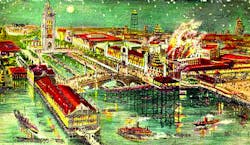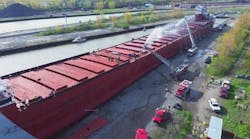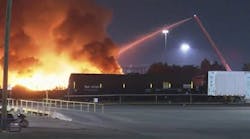BANGOR, ME: MAY 1, 1911 – A late-afternoon fire that began a day earlier was finally brought under control after midnight. The blaze originated in a hay shed near the corner of Broad and Union streets, apparently started by a cigarette cast aside during a poker game. The flames swept northward, fanned by a strong wind. The fire continued spreading north along Broad Street before leaping across the Kenduskeag Stream and continuing along Exchange Street. Firemen struggled to gain a foothold, but had little effect as the wall of fire destroyed everything in its path. Lost to the flames were banks, office buildings, the post office and high school, numerous commercial structures, seven churches and even the Central Fire Station. The new City Hall was spared as flames went over and around the building. Help arrived in the early evening when firemen from Augusta, Lewiston, Portland and Waterville joined the effort. Sadly, two firemen were killed battling the flames. Fireman George Abbott was killed by a falling chimney and Fireman John Scribner was pinned by a collapsing wall.
PLAINFIELD, NJ: MAY 4, 1911 – An attic fire at the well-known estate of Mrs. Frederick Mead on East Front Street threatened the loss of both the house and its contents. As firemen pressed the attack on the flames, a contingent of society women rushed around the home safeguarding and removing valuables from possible fire and water damage. When the smoke cleared, more than $100,000 in damage was estimated on the roof and attic areas.
LAKE BLUFF, IL: MAY 7, 1911 – Fire broke out on the third floor of the Methodist Deacons’ Orphanage just after 8 P.M. Heroic nurses braved the thick smoke and heat to pull children from their beds and carry them down the stairs. As firemen arrived, a roll call of the orphans was taken and it was realized one child had been left behind. One nurse, Luella Hilger, yelled she would get him. Conditions were so bad that several men tried to hold the nurse back, fearing she would be killed in the flames. The nurse broke free, then dashed up the stairs and crawled down the smoke-filled hallway to the child’s room. In the meantime, Fireman Schinsky had entered a window by ladder and found the child. He handed the unconscious child to the nurse and continued searching. The nurse rushed the 2-year-old boy outside, but the child, already quite sick with pneumonia, died from smoke inhalation.
EAGLE MILLS, NY: MAY 8, 1911 – A fire originating in a gasoline heater ignited the Church of Christ at 12:45 in the afternoon. The house of worship was quickly filled with flames as firemen struggled to gain control. The fire spread rapidly and brands were carried an eighth of a mile, setting fire to a barn on the banks of the Poestenkill Creek. Adjoining buildings were soon burning and radiant heat ignited several dwellings on the opposite bank. Firemen used telephones to request help from nearby Troy, which sent two of its steam pumpers. The fire was brought under control in four hours.
YAMAGATA, JAPAN: MAY 9, 1911 – This town, the capital of Yamagata Prefecture, was swept by a fire that destroyed more than 1,000 homes. Reports also indicated that banks, schools, a courthouse and government building were all lost to the flames.
UTICA, NY: MAY 21, 1911 – A woman mistakenly filled a lamp with gasoline before climbing the stairs to the second floor where her children were asleep. As she ignited the wick, the lamp exploded across the nearby two-gallon gasoline container that immediately burst into flames. Her husband quickly extinguished the woman’s burning dress before he dashed up the flaming stairs to rescue his five daughters. He moved the children to a window, leaped to the ground and stretched his arms up imploring them to jump. Before they could comply, flames swept through the room, killing them all.
BROOKLYN, NY: MAY 26, 1911 – A fire of near-conflagration proportions destroyed the huge Dreamland Park amusement park in Coney Island. Workers were putting the finishing touches on “Hellgate,” the last attraction being readied for the Memorial Day opening. This new attraction, a boat ride through the caverns of Hell, featured dimly lit canyons, rapids and a giant whirlpool. At 1:30 A.M., workers were using hot tar to repair the leaking watercourse when suddenly the lights went out. A bucket of bubbling tar was knocked over and within seconds flames were licking the rafters above. The first alarm was sent in at 1:58 and a second was transmitted upon arrival. An ocean breeze pushed the flames from one flimsy structure to the next and fire hose streams began to weaken. Multiple alarms were transmitted, but the failure of the new high-pressure hydrant system (pressure dropped from 160 pounds to 20 pounds) and the delayed response of horse-drawn apparatus, because of the great distance and time required, allowed the fire to grow unchecked. Four alarms and a “simultaneous call” (sending all apparatus that would have responded to a third alarm at Sixth Avenue and Twenty-third Street in Brooklyn to Coney Island) swelled the assignment to 50 fire companies. One of the attractions was the Baby Incubator Building, where six premature babies were quickly evacuated to safety. Other attractions featured numerous wild animals, including an elephant, lions and tigers. Trainers were able to control the animals until the lights went out – then the frightened animals turned on each other. In all, 60 trained animals perished.
Thousands of spectators drawn by the eerie red glow of the fire descended on the park and watched as the fire marched across the park. At 3:10, the huge Dreamland Tower, which had been burning like a roman candle for more than 30 minutes, fell with a fiery crash. The wind eventually changed, sending the gasping crowd home. With this help, firemen stopped the last of the flames. As the sun rose the next morning, Dreamland had been transformed into 15 acres of blackened, smoking ruins. The loss was more than $5 million. The park’s board of directors later sold the land back to the city.
RAHWAY, NJ: MAY 30, 1911 – Just after noon, a fire started among waste materials in the Royal Manufacturing Co. plant. Storehouse 1 was a roaring furnace as firemen arrived. With flames licking the exposed oil building next door and Storehouse 2, firemen pressed the attack hoping to stop the fire’s extension to both buildings. To add problems, the wind carried sparks to the roofs of residences along Grand and Bridge streets. The chemical engine raced from building to building, extinguishing six fires, while the remainder of the department brought the fire under control without extension.






